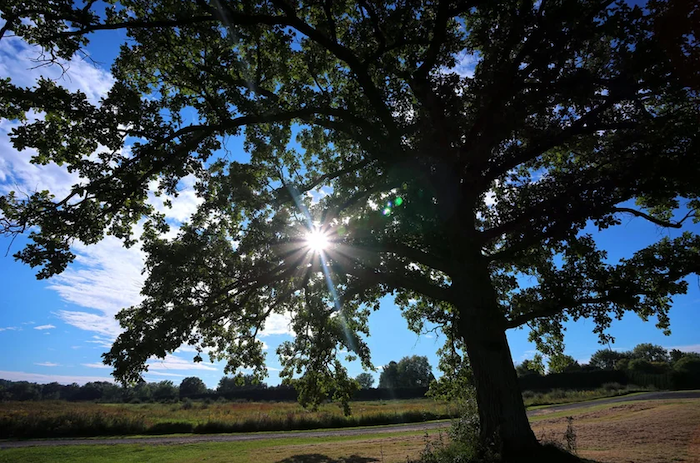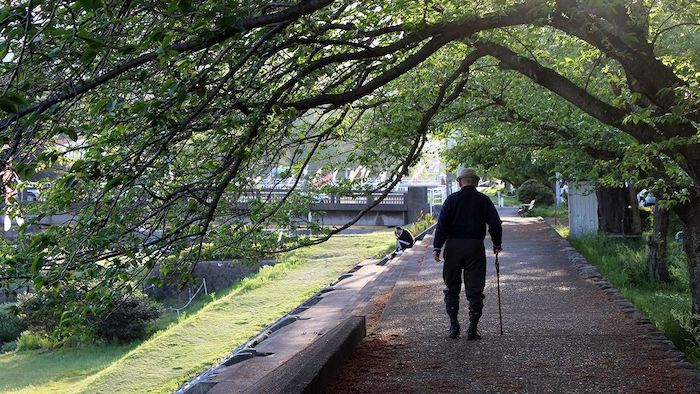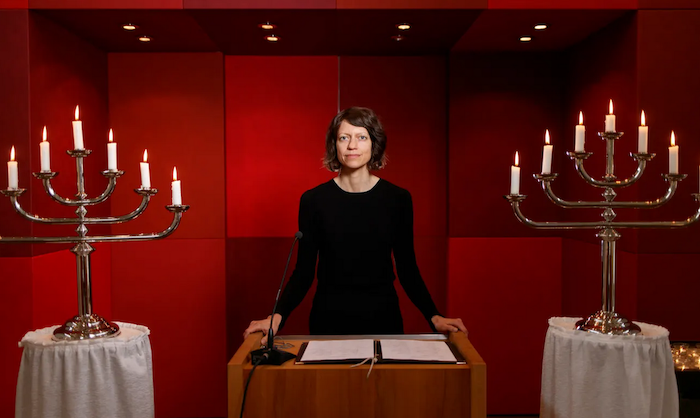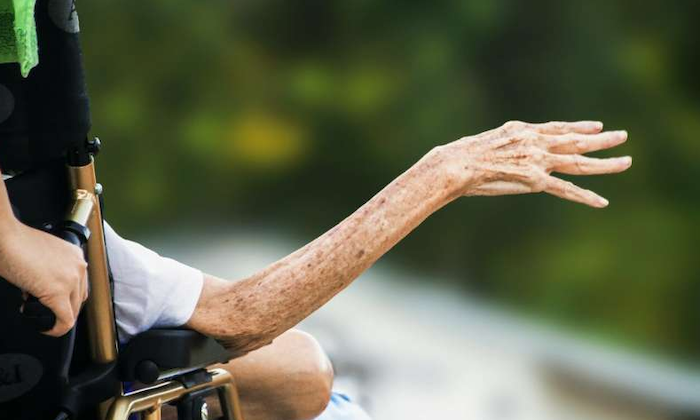Natural burials can remind us that death and grief are natural, too.

By Jake Maynard
Basil Eldadah assumed his father’s funeral would be simple. Years before, Basil’s father had taken steps to make the process easy on the family, purchasing plots and making arrangements. But in 2012, when his father died, Eldadah and his family discovered how complicated and impersonal the American funeral industry could be.
First, Eldadah learned that what his father had purchased was only the plot itself. Digging the grave, installing the concrete grave liner, and filling in the gravesite were not included. But the larger issue was that the cemetery required the use of a vault or burial liner: a concrete box that encases the coffin, keeping dirt from collapsing the casket. Eldadah’s family is Muslim, and it’s customary in Muslim traditions for a body to be placed directly in the soil. He described Muslim burial as “a process that reminds us of the humility of being from dust and returning to dust.” But most American cemeteries require concrete vaults or grave liners to prevent dirt settling at the gravesite—it makes the cemeteries easier to mow and eliminates the spooky depressions overtop graves—despite the fact that it is counter to the religious traditions of Muslims and some Jewish denominations. For Eldadah’s father, the best the family could do was to add some dirt to the inside of the vault.
>Later, as the grief began to lift, Eldadah questioned whether there was a more reverent, natural approach to burial. As an active member of his local Muslim community and as a researcher who studies aging, he knew that his experience wasn’t unique. “My father’s funeral really kind of planted the seed in my mind,” he told me. He eventually learned that there is a name for what he wanted: a green burial ground.
Green burial doesn’t have an official definition but generally refers to a range of cemetery practices that limit fossil fuel usage and the amount of human-made materials put into the ground. More broadly, the green burial movement wants to help people approach death with a more natural, and less commercial, outlook.
Green cemeteries substitute exotic hardwood caskets with renewable wood coffins or burial shrouds, and they don’t line graves with concrete. They shun mown lawns for native grasses and trees. Some green cemeteries mark graves with native stone or plant memorial trees; others don’t mark graves at all. They reject embalming as unnatural, unnecessary, and toxic. (Embalming chemicals contribute to high rates of cancer in mortuary workers.) Green cemeteries look more like nature preserves or parks than the orderly cemeteries we’re accustomed to.
The nonprofit Green Burial Council certifies cemeteries as green—it’s kind of like LEED building certification—and keeps tabs on the environmental impact of conventional burial. It says that each year American burials put more than 4 million gallons of embalming fluid, 20 million board feet of hardwood, 81,000 tons of metal, and 1.6 million tons of concrete into the ground. Cremation, promoted by the death care industry as the greener alternative, uses the equivalent of around 20 gallons of gasoline per cremation and vaporizes heavy metals (from dental fillings and surgical implants) into the atmosphere. While cremation conserves physical space, green burial conserves energy.
Burial wasn’t always so complicated. Embalming only gained traction among wealthy Americans during the Civil War, which essentially started the modern funeral industry. (Abraham Lincoln was embalmed for his funeral train, and reembalmed at many stops, but onlookers thought he looked nasty.) Concrete grave liners came later, allowing for today’s flat, uniform suburban cemeteries.
Generally speaking, laws governing burial are complicated and vague. In most states you can bury a loved one on your own property, but local zoning ordinances often contradict the state laws. While no states legally require embalming or grave liners, the funeral industry has made them so standard that in some places, they’re essentially requirements. Neither practice has any public health benefit, but embalming stretches the possible time between death and funeral. Embalming is popular only in the U.S. and Canada; in the rest of the world, it’s actually quite rare. Funeral homes have normalized embalming because it saves on refrigerator space and because they can sell larger funeral packages.
After his father’s funeral, Eldadah let his idea percolate until he found the right partner, one who’d also been surprised by the cost of a funeral. In 2019, Eldadah’s friend Haroon Mokhtarzada, a successful tech entrepreneur, received a call asking him to help fund the burial of a local community member. He was glad to help, but the cost rattled him.
“I was thinking it was going to be a couple hundred bucks and it was several thousand dollars,” he said. “And I came to learn that the average burial in Maryland is $10,500.” The national average, according to the National Funeral Directors Association, is about $9,000. (This chart shows how complicated itemized funeral expenses can be.) Mokhtarzada said, of the funeral’s cost, “There’s something that bothered me about that to my core.”
He asked, “Why does a hole in the ground cost $10,000?” The same use of embalming fluid, concrete, and hardwood that make death so polluting also make it expensive. According to the Bureau of Labor Statistics, funeral costs jumped 225 percent since 1986; GoFundMe hosted 125,000 memorial campaigns in 2020. Funeral poverty is an underreported crisis in America.
Eldadah had contacted Mokhtarzada previously about the project, but he was too busy to get involved. Seven years later, backed with his money and startup expertise, Mokhtarzada emailed Eldadah and said, “We’re going to make this thing happen.” Together, they set to work making metro D.C.’s first nonprofit green cemetery. If it works, it will be the most urban green cemetery in the U.S.
There are 82 cemeteries in America certified as green by the Green Burial Council (you can read about the certification standards here), but the movement has struggled to take hold near major cities due to the price of land. Pete McQuillin, who operates Penn Forest Natural Burial Ground near Pittsburgh, told me that it took him three years to find a property close to the city. In the nine years since Penn Forest opened, it has interred only 205 bodies. (Because people usually want to be buried next to their deceased loved ones, cemeteries are notoriously tough to get started.) But the number of burials is growing steadily every year, as does the execution of Penn Forest’s broader mission: It strives to be a multiuse park, hosting guided nature hikes, community roundtables on death, and a DIY coffin-making class.
Mokhtarzada and Eldadah have similar goals for their site, a woody, 40-acre plot in Silver Spring, Maryland, tucked between a concrete factory and a church. (The price? Almost $2 million.) When I first talked to them in July, they were excited to explain the project’s overarching goals. “We’ve started to envision a community-gathering place,” Mokhtarzada said. “Not just a creepy place where you only go to pay your respects and then you leave. But some place where people would want to spend quality time … a space where not only do the living serve the dead by providing simple, natural, and dignified burials, but also where the dead can fuel life.”
By December, they were feeling the weight of bureaucracy. In between fielding questions from their new neighbors about water quality and funeral traffic, the two men had poured $200,000 into the project before breaking ground. There were nonprofit lawyers, land-use lawyers, engineers, architects, permitting fees. And they were still struggling to come up with a name. Like burial, starting a cemetery was more complicated than anticipated.
While Mokhtarzada’s startup experience was helpful, he learned that the cemetery business is unique. “In a startup mode,” he said, “you just figure out as much as you need to figure out, you don’t figure out what this thing’s going to be in five and 10 years. But what I’ve found that was different in this creative process is we had to think decades into the future. We had to think in three dimensions in decades.”
To help with that part, Eldadah and Mokhtarzada hired architect Jack Goodnoe, who has designed some of America’s best-known green burial grounds. Goodnoe started designing conventional cemeteries in the 1980s and began working with green cemetery movement when the movement began in the late ’90s. While Goodnoe supports greening the death industry, he also thinks that green and conventional cemeteries need to learn from each other. The green burial movement has been led by charismatic industry outsiders—academics, environmentalists, spiritual types—with big ideas offset by a lack of knowledge about cemetery management. Goodnoe recommends that “when someone wants to start a green cemetery, they partner with a traditional cemetery that can bring all the legal, grief, record-keeping elements that they’ve learned from decades in the industry.”
Eldadah and Mokhtarzada don’t plan to work with a traditional cemetery, but they have implemented some conventional cemetery practices at Goodnoe’s recommendation. For example, some green cemeteries let people choose their own burial site anywhere on the property, which Goodnoe worries could lead to record-keeping issues for future cemetery managers. At their site, Eldadah and Mokhtarzada have taken Goodnoe’s advice of burying in one area at a time and evenly spacing gravesites like a conventional cemetery might.
They hope to open for burials in 2021 and have already generated some interest among the local Muslim community. But in order to fulfill their inclusive mission, Eldadah and Mokhtarzada will have to expand beyond green burial’s usual demographic. Hannah Rumble, an anthropologist who studies burial in the U.K., told me that green burial has been “quite a middle-class aesthetic and cultural practice,” and hasn’t yet become popular among the working-class people who could most benefit from lower burial prices (often less than half the price of conventional burial) and less upkeep responsibility. But traditions change slowly, she says, and as the last rite of passage, burial traditions are usually some of the last to change.
On a more spiritual level, Rumble has observed the way that green burial has influenced the grieving process of people she’s interviewed. She says, “The bereaved like to go over time to watch the trees grow, to watch the site developed to maturity, to watch the plants bed in. It’s interesting how their own emotional journey with grief has changed and how they see it reflected in the development of the natural burial ground. … And so now their visits are more about just going and enjoying the bird songs, seeing how the site’s developed, seeing what initiatives are going on. It becomes a kind of community, a community of practice.”
This sentiment is ultimately how the green burial movement overlaps their ecological and spiritual goals. Conventional cemeteries, with their permanent headstones and concrete grave liners, encourage us to think that even in death, we’ll last forever. What natural burial offers is the reminder that death and grief are like all natural processes: They change and evolve, grow and decay. Like Rumble says, “I think what’s really powerful about that ecological metaphor is it’s fairly timeless. And it’s one that, irrespective of your faith, people can relate to.”
Complete Article ↪HERE↩!






